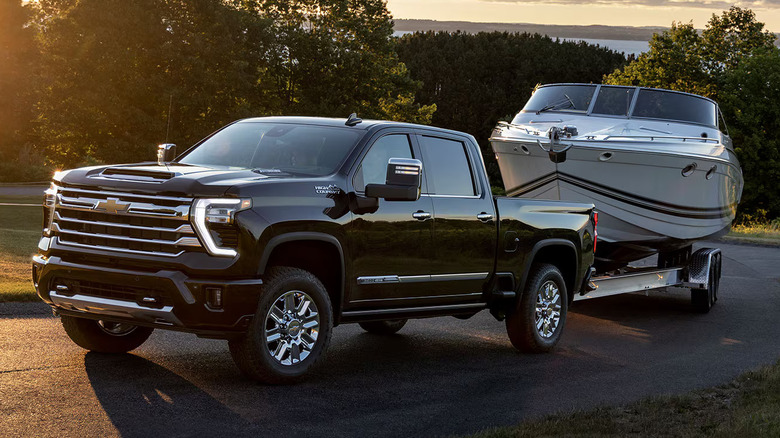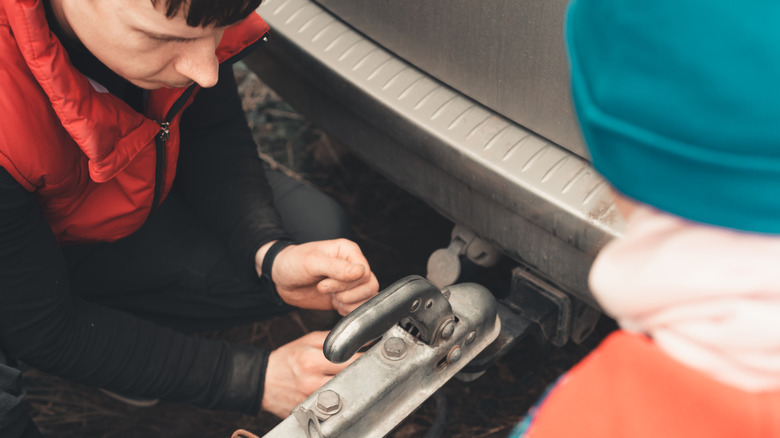How To Properly Load A Trailer For Balanced Towing
Towing safely has less to do with your vehicle's horsepower or expensive towing accessories and a lot more to do with how your trailer is loaded. Most people don't think about how they've loaded a trailer until it becomes impossible to ignore. What might feel like a slight wobble in the rearview mirror can quickly turn into violent swaying that even expert drivers can't drive out of. This type of instability almost always comes down to poor weight distribution. And calculating the right weight distribution for your particular setup isn't nearly as complicated as it sounds, either.
Manufacturers, trailering guides, and federal safety guidance suggest keeping 10-15% of the total trailer weight on the tongue (the part of the trailer attached to your hitch) and arranging your cargo with a 60/40 front-to-back split for balanced towing. These numbers prevent overloading the trailer's axles, reduce uneven tire wear, and most importantly, keep your trailer from fishtailing. Here's exactly how to apply these principles correctly — so the load you start with is the load you finish with.
How to calculate the perfect tongue weight
If you haven't measured the tongue weight and are just guessing, you're putting both your trailer and your safety at risk. If it's lower than 10% of your trailer's total loaded weight, the trailer can lose its footing and start swaying — sometimes violently enough to overpower the tow vehicle. If it's too high, your tow vehicle's rear end can squat with the extra weight, which lightens the front tires and makes steering and braking less effective.
The easiest way to get an exact tongue weight is with a dedicated tongue weight gauge — a portable device that directly measures the downward force the trailer places on your vehicle's hitch. To use one, get the scale into place under the trailer's tongue jack, crank the jack until the trailer settles on it, and wait for the number to stabilize. That's your tongue weight.
If you don't feel like shelling out for a tongue weight scale, a CAT scale at a nearby truck stop works just as well. Start by weighing your tow vehicle by itself first. Then hitch up the trailer and weigh your tow vehicle again – but keep the trailer's axles off the scale. The difference between the two numbers is the actual tongue weight your trailer is placing on the hitch. Once you've got the number, it's just as important to know if your hitch and tow vehicle are rated to handle it. Tongue weight capacity is not the same as total towing capacity. Check your measured tongue weight against both ratings — they need to match or exceed the measured tongue weight figure. A hitch rated for only 1,000 pounds won't safely support 1,200 pounds, no matter how strong your truck is.
How to load and secure cargo for maximum stability
Once tongue weight is set, arrange your cargo by loading more than half of your total cargo — around 60% — toward the front half, ahead of the axles, with the rest toward its rear. This front-weight bias helps "plant" the trailer instead of letting it move freely on bumps and turns, and reducing rear-heavy fishtailing. If your loaded trailer feels or looks crooked when towing, it's probably because one side is carrying more weight. This can wear out suspension parts on the heavier side, chew up tires, and even unsettle cargo on uneven pavements, so it needs to be fixed.
Once everything's placed correctly, secure it like it matters. Use heavy-duty ratchet straps in a diagonal cross-pattern to ensure nothing moves out of its place when you're towing. After traveling the first few miles, always pull over and recheck your tie-down straps — even minor vibrations can loosen them without warning. Follow these simple rules — proper tongue weight, smart cargo balance, and use reliable tow straps — and you'll tow smoothly and safely, without any unwanted surprises.


